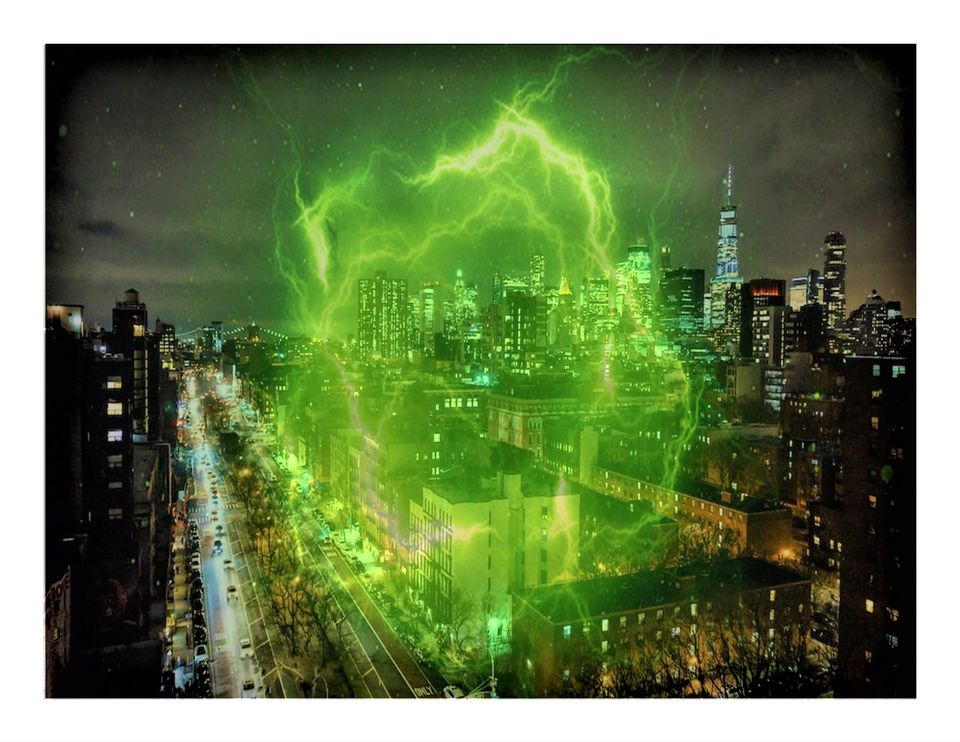Nighttime Landscapes: A Memory of Iridescent Green

First Published in the Adelaide Literary Magazine Awards Anthology of 2018
The porch was elegant and functional. It extended from the front door to the yard in a delicate way that discouraged lounging and accented the sprawling length of the house. This was the time of American middle-class prosperity, the postwar era, and such features truly spoke to the context of a home and to its character. Constructed at the height of midcentury modern design, the ranch house next door was similar to ours in many ways, the floorplan, the lush but small front yard, and the overall décor of modest prosperity. I remember it well. Just beyond the concrete slab — that minimal but elegant porch — was an outcropping of ivy that thrived year-round and undulated like a sea of sprouting tentacles. At night, when the accent light was on, iridescent green flooded the leaves, giving them a glow that reminded me of a dream, an atmosphere at once soothing and menacing. This is my memory of the neighbors’ front yard. Looking back, it speaks, not only to childhood imagination but to my curiosity about darkness and the landscapes of night.
On Halloween, costumed trick or treaters would approach with caution, clad in plastic costumes from the drugstore, flashlights in-hand, ever mindful of the older couple who would approach them from the cold, concrete slab, administering small candy bars along with a hint of suspicion. Who were these children? Did they emerge from the surrounding homes anticipating a handout? Who were the neighbors? At night, in the restrained suburban atmosphere, the cordial tones of daylight disappeared into darkness. Children from other areas, less familiar to the neighbors, were hurried away until the following year. The flood lights were a caution as much as an invitation. In similar fashion, Christmas guests would approach the house quietly, always hidden in shadows of iridescent green, bearing gifts and speaking in slightly hushed tones. These were the festivities I remember from childhood.
As an adult, mysterious hues and colorful illuminations of night remain intriguing to me, in the neon expressions of Las Vegas, the bar scene of downtown Los Angeles, and the sprawling cityscapes of Manhattan. All such environments remind me of the peaceful yet haunting presence of my neighbors’ yard. Perhaps the effect would have been lessened had they chosen a less obvious color, like blue, or even purple. Fortunately, the symbolism of nature was indispensable to them. And what about this color and its undeniable impact?
Green. On one of my nighttime journeys to a bookstore, I came upon a memorable work by Kassia St. Clair, The Secret Lives of Color. “Verdigris, absinthe, emerald, Kelly green, Scheele’s green, terre verte, avocado, celadon,” she lists the various shades in a wonderful narrative. From the artist’s pallet to the medicinal and culinary aspects of the color, St. Clair tells us the story of green. Looking back, I find that emerald perhaps best describes my childhood recollection of the hue, as it was made to glow and hint at the nether realms of suburbia. Also, I remember that my neighbors’ use of green made it feel quite spontaneous and free, although it remained malleable to the eye of landscape designers. But there is one final connection I found between the color and my memory of night, the one that took place at the end of my mother’s life.
Just prior to my mother’s death in a nursing home, after a two-month battle with a rampant infection, I was reminded of green.
One night, as I looked at old photographs, I found an image of her on vacation in the Midwest, a trip taken during the 1950s. It was a candid black and white picture that captured her as she examined her own camera, one of those ancient devices that required the viewer to glance through a lens mounted on top. I remember it, because, although caught forever in shades of gray, her dress was avocado green, a favorite of hers that she described to me when I was a child. Those images — the ephemeral life of greenery, the glow of the house next door, and the strange gray tones of illness and demise — all merge into a picture of my childhood, a landscape of night and a memory of iridescent green.